Cyrix
 Cyrix Corporation was a semiconductor company that was known for producing x86 microprocessors. Cyrix Corporation, was a manufacturer of computer processor solutions. For the better part of a decade, Cyrix brought the world of personal computing to millions in the form of attainable budget PCs. The company became a subsidiary of National Semi Conductor from November of 1997. National Semiconductor ran into financial trouble soon after the Cyrix merger, and these problems hurt Cyrix as well. By 1999, AMD and Intel were leapfrogging one another in clock speeds, reaching 450 MHz and beyond while Cyrix took almost a year to push the MII from PR-300 to PR-333. National Semiconductor distanced itself from the CPU market, and without direction, the Cyrix engineers left one by one. By the time National Semiconductor sold Cyrix to VIA Technologies. National Semiconductor retained the MediaGX design for a few more years, renaming it the Geode and hoping to sell it as an integrated processor. They sold the Geode to AMD in 2003.
Cyrix Corporation was a semiconductor company that was known for producing x86 microprocessors. Cyrix Corporation, was a manufacturer of computer processor solutions. For the better part of a decade, Cyrix brought the world of personal computing to millions in the form of attainable budget PCs. The company became a subsidiary of National Semi Conductor from November of 1997. National Semiconductor ran into financial trouble soon after the Cyrix merger, and these problems hurt Cyrix as well. By 1999, AMD and Intel were leapfrogging one another in clock speeds, reaching 450 MHz and beyond while Cyrix took almost a year to push the MII from PR-300 to PR-333. National Semiconductor distanced itself from the CPU market, and without direction, the Cyrix engineers left one by one. By the time National Semiconductor sold Cyrix to VIA Technologies. National Semiconductor retained the MediaGX design for a few more years, renaming it the Geode and hoping to sell it as an integrated processor. They sold the Geode to AMD in 2003.
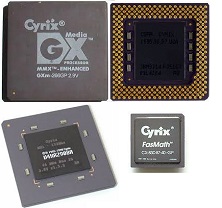 Cyrix Corporation headquartered in Richardson, Texas, was a leading supplier of high-performance processors to the personal computer industry. The company designed, manufactured innovative Windows™-compatible processors. Cyrix customers include Acer, Compaq, CTX, Cybermax, Fujitsu, IBM, NEC, Samsung and Vobis. The Cyrix 6×86 processor has been recognized for its performance with awards from a number of publications, including Byte Magazine’s Best Technology at CeBIT’96, Computer Reseller News’ Editor’s Choice Award, PC Week’s Corporate IT Excellence Award and Computer Shopper’s Direct Channel Excellence Award.
Cyrix Corporation headquartered in Richardson, Texas, was a leading supplier of high-performance processors to the personal computer industry. The company designed, manufactured innovative Windows™-compatible processors. Cyrix customers include Acer, Compaq, CTX, Cybermax, Fujitsu, IBM, NEC, Samsung and Vobis. The Cyrix 6×86 processor has been recognized for its performance with awards from a number of publications, including Byte Magazine’s Best Technology at CeBIT’96, Computer Reseller News’ Editor’s Choice Award, PC Week’s Corporate IT Excellence Award and Computer Shopper’s Direct Channel Excellence Award.
Despite its innovations and cost-effective solutions, Cyrix faced various challenges, including technical and marketing hurdles. The company was eventually acquired by National Semiconductor Corporation in 1997. The Cyrix brand continued to exist for a while, and National Semiconductor continued to release processors under the Cyrix name. However, the brand gradually faded from the market. Cyrix Semiconductor was founded in 1988 by Jerry Rodgers, who with the help of a small but elite team of fellow ex-Texas Instruments engineers built a fabless semiconductor design company that created CPU chips. Their technical performance rivaled, and even surpassed, that of industry giants Intel, IBM and AMD. At various times, the actual manufacture of Cyrix chips was done by Texas Instruments, SGS Thomson and IBM. Over the course of time, rigorous competition with much better funded competitors and patent infringement lawsuits weakened Cyrix and forced it to seek financially stronger partners. Cyrix was eventually sold to National Semiconductor in 1997.
Cyrix x86 microprocessors
-
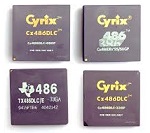 Cyrix 486:Cyrix initially gained recognition with its 486 processors, which were designed to be compatible with Intel's 486 processors. These chips provided an economical option for consumers and system builders.
Cyrix 486:Cyrix initially gained recognition with its 486 processors, which were designed to be compatible with Intel's 486 processors. These chips provided an economical option for consumers and system builders. -
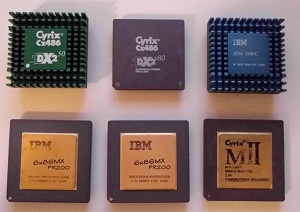 Cyrix 5x86:One of Cyrix's more successful products was the Cyrix 5x86. This processor was designed to work in systems with 486 motherboards but offered performance comparable to early Pentium processors. The Cyrix 5x86 processor, formerly called the M1sc, is first in a family of processors for desktop and mobile systems. With its fifth-generation architectural core, the 5x86 processor gives users an affordable performance alternative to the Intel Pentium processor with a market-ready socket solution. The Cyrix 5x86 is initially available in a 168-pin PGA or a 208-pin QFP package.
Cyrix 5x86:One of Cyrix's more successful products was the Cyrix 5x86. This processor was designed to work in systems with 486 motherboards but offered performance comparable to early Pentium processors. The Cyrix 5x86 processor, formerly called the M1sc, is first in a family of processors for desktop and mobile systems. With its fifth-generation architectural core, the 5x86 processor gives users an affordable performance alternative to the Intel Pentium processor with a market-ready socket solution. The Cyrix 5x86 is initially available in a 168-pin PGA or a 208-pin QFP package.
-
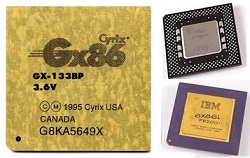 Cyrix 6x86 (M1): In 1996, Cyrix unveiled the 6x86 (M1) processor. The Cyrix 6x86, codenamed "M1," was a significant release. It utilized a different microarchitecture that aimed to provide better performance per clock cycle compared to traditional Intel and AMD processors of the time. However, marketing and branding challenges led to some confusion among consumers. The M1 was another drop-in replacement for Intel CPUs on Socket 5 and Socket 7 motherboards. The Cyrix 6x86 was actually a marvel in CPU design that was thought to do the impossible, it combined a RISC core with many of the design aspects of a CISC one. At the same time, it continued to use native x86 execution and ordinary microcode, while Intel's Pentium Pro and the AMD K5 relied on dynamic translation to micro-operations.
Cyrix 6x86 (M1): In 1996, Cyrix unveiled the 6x86 (M1) processor. The Cyrix 6x86, codenamed "M1," was a significant release. It utilized a different microarchitecture that aimed to provide better performance per clock cycle compared to traditional Intel and AMD processors of the time. However, marketing and branding challenges led to some confusion among consumers. The M1 was another drop-in replacement for Intel CPUs on Socket 5 and Socket 7 motherboards. The Cyrix 6x86 was actually a marvel in CPU design that was thought to do the impossible, it combined a RISC core with many of the design aspects of a CISC one. At the same time, it continued to use native x86 execution and ordinary microcode, while Intel's Pentium Pro and the AMD K5 relied on dynamic translation to micro-operations.
-
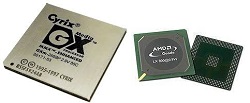 Cyrix MediaGX: The introduction of the MediaGX processor in February 1997 defined the first new PC architecture in a decade, and ignited a new market category, the low-cost Basic PC. The Cyrix MediaGX processor was designed for low-cost, energy-efficient computers. It integrated the CPU, graphics, and audio functions onto a single chip, making it suitable for basic computing tasks. The MediaGX had been considered a performance product in 1996. The MediaGX name was kept by the Cyrix division of National Semiconductor; until 1999 when National Semiconductor redesigned the CPU into the NS Geode.
Cyrix MediaGX: The introduction of the MediaGX processor in February 1997 defined the first new PC architecture in a decade, and ignited a new market category, the low-cost Basic PC. The Cyrix MediaGX processor was designed for low-cost, energy-efficient computers. It integrated the CPU, graphics, and audio functions onto a single chip, making it suitable for basic computing tasks. The MediaGX had been considered a performance product in 1996. The MediaGX name was kept by the Cyrix division of National Semiconductor; until 1999 when National Semiconductor redesigned the CPU into the NS Geode.
In 1999 National Semiconductor sold Cyrix to VIA of Taiwan, however they retained the MediaGX line and continues to produce it themselves under MediaGX, as well as the "Geode" name. Even though mainstream processors were heading towards 1GHz speeds, the MediaGX was still in the 200-300MHz range, more then adequate for lots of industrial computers, as well as TV set-top box style computers.
MediaGX was used to power the OLPC (One Laptop Per Child) Project. In 2003 AMD purchased the Geode line from National Semiconductor and further marketed and enhanced it. Clock speed was boosted to 600MHz while power requirements dropped to the sub 1 Watt range. AMD expanded the Geode series to two classes of processor: the MediaGX-derived Geode GX and LX, and the modern Athlon-derived Geode NX. Geode processors are optimized for low power consumption and low cost while still remaining compatible with software written for the x86 platform. The MediaGX-derived processors lack modern features such as SSE and a large on-die L1 cache but these are offered on the more recent Athlon-derived Geode NX. Geode processors tightly integrate some of the functions normally provided by a separate chipset, such as the northbridge. Whilst the processor family is best suited for thin client, set top box and embedded computing applications. AMD continued to produce and enhance the Geode (GX and LX versions) until 2006 when they transitioned to the Athlon Thoroughbred cored NX version.